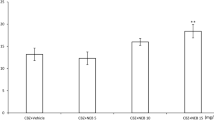Abstract.
Clenbuterol, a lipophilic β2-adrenoceptor agonist, was investigated in various seizure models of experimental epilepsy. In the maximal electroshock seizure threshold test, clenbuterol (≥4 mg/kg i.p.) increased the electroconvulsive threshold for tonic seizures in mice. In the traditional maximal electroshock seizure (MES) test in mice, ED50 values of 11 mg/kg i.p. or s.c. were determined. In both models, the β2-receptor antagonist ICI 118.551 did not antagonize the anticonvulsant activity of clenbuterol. Combinations of clenbuterol with standard antiepileptics revealed additive anticonvulsant effects. Repeated administration of clenbuterol (5 mg/kg s.c., twice daily for 14 days) to mice did not significantly influence its anticonvulsant potency or the effectiveness of phenobarbital in the MES test. In various chemically-induced seizure tests with tonic convulsions, clenbuterol inhibited or tended to suppress the tonic phase. However, this drug was not effective in preventing clonic seizures in the pentylenetetrazol (85 mg/kg s.c.) seizure threshold test. In the rotarod ataxia test (mice), a minimal "neurotoxic" dose (TD50) of 41 mg/kg i.p. was determined. In unrestrained rats with chronically implanted electrodes in the dorsal hippocampus, clenbuterol (2 mg/kg and 4 mg/kg i.p.) significantly reduced the duration of electrically evoked hippocampal afterdischarges. In amygdala-kindled rats, clenbuterol (5 mg/kg and 10 mg/kg i.p.) reduced the seizure severity to stage 3. Additional studies indicated that clenbuterol (6 mg/kg i.p.) increased the heart rate and decreased the blood pressure, but this drug did not alter the plasma level of the two tested antiepileptics phenobarbital and carbamazepine. Furthermore, in whole-cell voltage-clamp experiments on cultured neonatal rat cardiomyocytes, clenbuterol (1–100 µM) depressed the fast sodium current in a concentration- and frequency-dependent manner. In conclusion, the anticonvulsant effects of higher doses of clenbuterol against generalized tonic-clonic and complex partial seizures seem to be related to the inhibition of voltage-dependent sodium channels and not to the modulation of β-adrenoceptors.
Similar content being viewed by others
Author information
Authors and Affiliations
Additional information
Electronic Publication
Rights and permissions
About this article
Cite this article
Fischer, W., Kittner, H., Regenthal, R. et al. Anticonvulsant and sodium channel blocking activity of higher doses of clenbuterol. Naunyn-Schmied Arch Pharmacol 363, 182–192 (2001). https://doi.org/10.1007/s002100000341
Received:
Accepted:
Issue Date:
DOI: https://doi.org/10.1007/s002100000341



